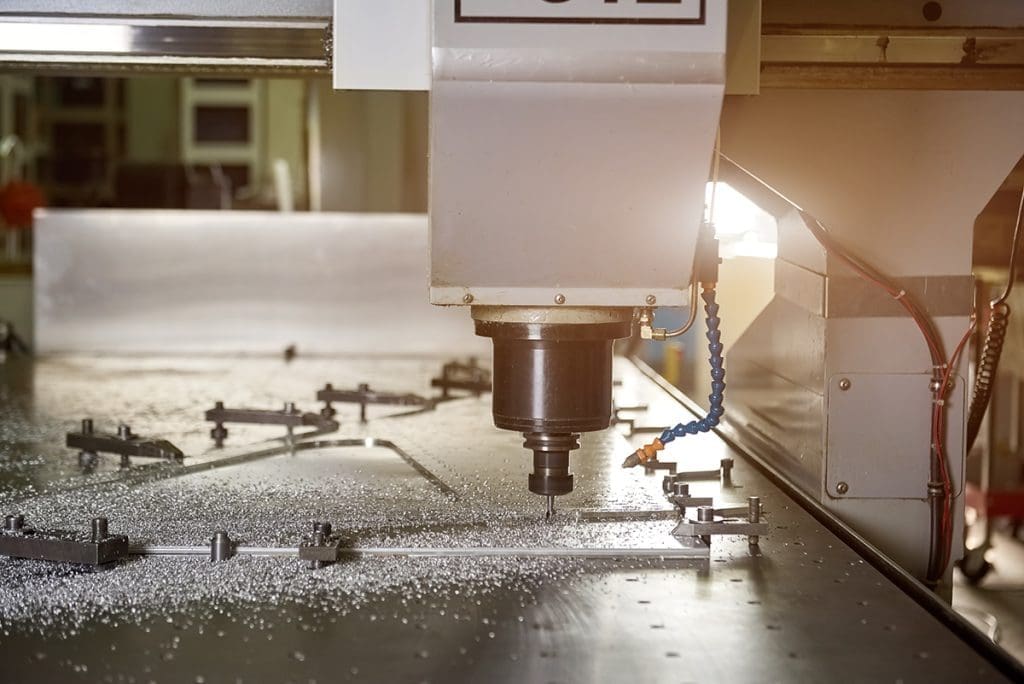Are you frustrated by machining errors? Have you missed deadlines because of slow or inefficient manufacturing processes? CNC machining might be the answer to your production needs. Computer numerical control, or CNC, machining is a robotized method of fabricating goods from stock material. Dozens of industrial applications, from medical devices to the automotive industry, use this production method.
When your production needs aren’t being met, look for a metal fabrication shop that can better use the industry tools to get you the desired parts. When human error is a risk you can’t take, look to computer-aided machining for an exacting production that can machine parts far faster than hand-performed tooling. Call us today and learn how we use CNC milling machines and CNC technology to get the most for our customers.
What Is CNC Machining?
Computer Numerical Control (CNC) machining is a general term for any method that uses computer-controlled tools to manufacture products. CNC uses computerized devices and design software to produce parts with extremely high accuracy and productivity. CNC processes can give highly consistent results for projects with low error tolerance.
CNC machining can describe several processes, including CNC milling, drilling, and turning machines. Milling machines use a rotating bit moving about a piece to remove material. Turning machine tools, a rotating metal rod, stationary cutting tools, and drilling machines drill holes into the piece, usually for screws and bolts.
What Types of CNC Machines are Commonly Used?

From woodworking to metalworking, plastics to electronics, CNC machines are used throughout dozens of processes and industries today. Every CNC machine has particular uses that allow this class of machine to fit into niche production goals easily. Some use diamond-tip drills or high-power water jets to cut and drill material, but standard cutting tools are also often used.
CNC mills, lathes, routers, cutters, grinders, and other CNC machines are common throughout industrial manufacturing thanks to the speed and efficiency of their work. You will likely see these at any high-productivity wood shop or metal shop. The precision, speed, and strength of CNC machining technology allow rigid materials to be tooled without difficulty, perfect for stainless steel and stone processing.
What Does the CNC Machining Process Look Like?
CNC machining requires several steps to ensure that the parts will be created properly according to manufacturing directives. To ensure the finished product matches all of the needs and goals of the designers and engineers, every CNC machining technology process begins with a computer model:
Design the CAD model
Computer-aided design software programs give the production process an easy-to-transfer and use a model that will be used across the process. The designer, engineer, or manufacturer often creates a digital model based on a physical prototype. But sometimes, creating a model from scratch is necessary, making digital computers invaluable for the design process. Creating new and complex parts can involve much trial and error, wasting time and material. The digital design and modeling step allows manufacturers to keep waste low.
Convert the CAD file into CNC Programming
CNC machining tools have pre-programmed software to tell them exactly how to move the routers and other tools to cut or mill the piece into shape. Converting the CAD software file into a CNC program can take time and effort to consider how the CNC machine tools will move around the part. This needs careful consideration to prevent damage to the machine tool itself.
Prepare the CNC Machine
CNC machines must be carefully prepared to prevent the machines from shifting during machining. The complex machinery of a CNC machine will require careful cleaning, oiling, and other maintenance between CNC part machining. This keeps the process efficient and fast, resulting in higher production rates.
Execute the Machining Operation
Once the machining systems are ready, the manufacturing process can begin. The CNC operator will ensure the enclosure or work area is clear, and the CNC machinery can be set in motion. CNC machinists will monitor the manufacturing process as it runs, ensuring no errors occur. CNC machine training involves monitoring for signs of overheating, sticking, and other issues that might arise throughout daily work – though proper maintenance ensures errors are rare.
What Types of CNC Machining Software are Commonly Used?
CNC machining technology requires a specifically designed model of what you want to machine. This requires software that can provide not only a 3D model but also specific information about the material and manufacturing process. There are three major types of CNC machining software:
- Computer-aided Design (CAD) software
- Computer-aided Manufacturing (CAM) software
- Computer-aided Engineering (CAE) Software
Each one has unique technical differences resulting from its industry standards, expectations, and processes. But each one can be used in much the same way. 3D models and design specs can be converted into CNC machine programming.
Manufacturing is Faster Than Ever Before with CNC Machining Technology!
If you have struggled with slow or error-filled productions, then a metal fabrication shop that uses CNC machining technology can help you stay on schedule and keep your production costs lower than ever before. Enjoy your manufactured products in large quantities and with minimal energy consumption! From lathes to cutters, CNC machines will provide access to the exact parts and pieces you need to make.
So, discuss your needs and expectations with Brandywine Valley Fabricators, central Pennsylvania’s leading expert in metal fabrication. Nestled in beautiful Coatesville, our shop uses dozens of methods, tools, and machines to get our clients the best metal fabrication results. Call today!

